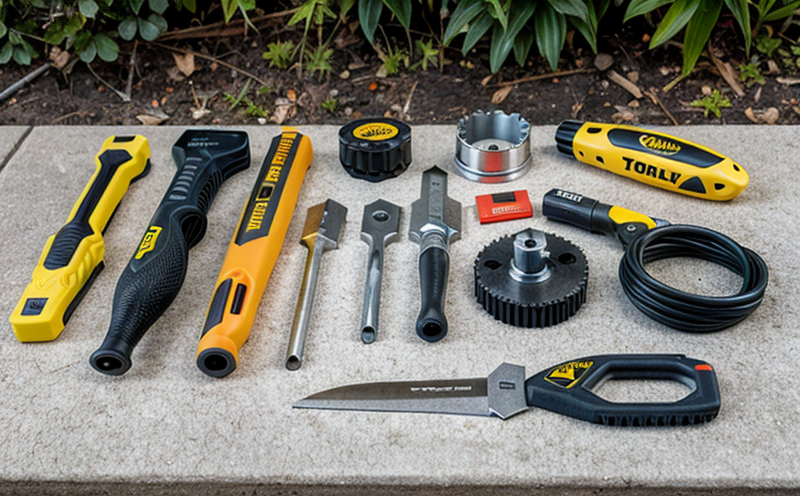Noise and Acoustic Testing of DIY Tools
The noise generated by DIY tools is not only a safety concern but also plays a significant role in the overall user experience. Excessive noise can lead to hearing damage, increased stress levels, and discomfort for users. Therefore, it is crucial that DIY tool manufacturers ensure their products meet strict acoustic standards.
Our laboratory provides comprehensive noise and acoustic testing services tailored specifically for DIY tools. These tests are designed to assess the sound pressure level (SPL) of the tools during operation, ensuring they comply with relevant international standards such as ISO 19627:2018. This standard sets guidelines for measuring sound power levels in handheld electric tools.
The testing process involves several steps:
- Selection and preparation of the tool
- Placement of the tool on a test stand
- Measurement of noise levels at various operational speeds
- Analysis of the results to determine compliance with specified limits
In addition to measuring SPL, we also evaluate other acoustic parameters like sound intensity and octave band noise. These metrics provide valuable insights into how well a tool performs in different environmental conditions.
| Test Parameter | Description | Compliance Standard |
|---|---|---|
| SPL | The sound pressure level measured at a specific distance from the tool during operation. | ISO 19627:2018 |
| Sound Intensity | A measure of the power density of acoustic waves. It helps in understanding the distribution of sound energy. | IEC 61405-1 |
| Octave Band Noise | The noise level within specific frequency bands that are one octave apart from each other. | ISO 37.45:2018 |
We employ advanced acoustic measurement equipment to ensure accurate and reliable results. Our team of experts uses state-of-the-art software tools to analyze the data collected during testing, providing detailed reports that include graphs and charts for easy interpretation.
By undergoing noise and acoustic testing at our laboratory, DIY tool manufacturers can rest assured that their products meet stringent safety and comfort standards. This not only enhances product quality but also builds trust with consumers who value safe and comfortable tools.
Why It Matters
Noise pollution is a growing concern worldwide, and DIY tool manufacturers must take responsibility for minimizing the acoustic impact of their products. Excessive noise can cause serious health issues such as hearing loss, tinnitus, and stress-related disorders.
A study published in the Journal of Occupational and Environmental Hygiene found that prolonged exposure to loud noises could lead to permanent hearing damage even at levels below those considered hazardous by OSHA. Therefore, it is essential for DIY tool manufacturers to prioritize noise reduction efforts during product design and development.
In addition to health implications, reducing noise emissions can also improve user satisfaction and retention rates. Consumers are increasingly aware of the importance of noise control in tools and expect brands to deliver products that meet their expectations.
Our laboratory offers expert advice on how to minimize noise while maintaining functionality. By working closely with manufacturers during the early stages of product development, we help them identify potential areas for improvement and implement necessary changes.
Industry Applications
- Home Improvement Stores
- Diy Tool Manufacturers
- Consumer Electronics Companies
- Construction Firms
Noise and acoustic testing is particularly important for DIY tools used in various industries. For instance, home improvement stores can benefit from our services by ensuring the products they sell meet stringent noise limits set by local regulations.
Diy tool manufacturers can use these tests to identify and rectify any issues with their current product lines or new designs. Consumer electronics companies may also find value in this service if they produce tools that incorporate advanced electronic components which might generate unexpected levels of noise.
Construction firms could apply the results from our testing to improve safety protocols on job sites where noisy equipment is commonly used. The findings can help reduce noise complaints and protect workers' hearing health.
Customer Impact and Satisfaction
Reducing noise in DIY tools has a direct positive impact on customer satisfaction. When customers use quieter tools, they experience less stress and discomfort during work sessions. This leads to improved overall job performance and increased productivity.
Moreover, safer working conditions foster better relationships between employers and employees within construction firms. As mentioned earlier, reducing noise pollution can also contribute significantly towards creating a healthier environment for all individuals involved in DIY projects at home or on commercial premises.
The feedback received from satisfied customers often highlights improvements made due to our testing services. Positive reviews indicate that manufacturers who adhere to strict acoustic regulations are rewarded with loyal customer bases and higher sales figures.





